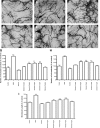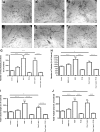Chemerin, a novel adipokine in the regulation of angiogenesis - PubMed
. 2010 May;95(5):2476-85.
doi: 10.1210/jc.2010-0042. Epub 2010 Mar 17.
Joanne E Curran, Claire J Stocker, Mohamed S Zaibi, David Segal, Nicky Konstantopoulos, Shona Morrison, Melanie Carless, Thomas D Dyer, Shelley A Cole, Harald H H Goring, Eric K Moses, Ken Walder, Michael A Cawthorne, John Blangero, Jeremy B M Jowett
Affiliations
- PMID: 20237162
- PMCID: PMC2869547
- DOI: 10.1210/jc.2010-0042
Chemerin, a novel adipokine in the regulation of angiogenesis
Kiymet Bozaoglu et al. J Clin Endocrinol Metab. 2010 May.
Abstract
Context: Chemerin is a new adipokine associated with obesity and the metabolic syndrome. Gene expression levels of chemerin were elevated in the adipose depots of obese compared with lean animals and was markedly elevated during differentiation of fibroblasts into mature adipocytes.
Objective: The objective of the study was to identify factors that affect the regulation and potential function of chemerin using a genetics approach.
Design, setting, patients, and intervention: Plasma chemerin levels were measured in subjects from the San Antonio Family Heart Study, a large family-based genetic epidemiological study including 1354 Mexican-American individuals. Individuals were randomly sampled without regard to phenotype or disease status.
Main outcome measures: A genome-wide association analysis using 542,944 single-nucleotide polymorphisms in a subset of 523 of the same subjects was undertaken. The effect of chemerin on angiogenesis was measured using human endothelial cells and interstitial cells in coculture in a specially formulated medium.
Results: Serum chemerin levels were found to be highly heritable (h(2) = 0.25; P = 1.4 x 10(-9)). The single-nucleotide polymorphism showing strongest evidence of association (rs347344; P = 1.4 x 10(-6)) was located within the gene encoding epithelial growth factor-like repeats and discoidin I-like domains 3, which has a known role in angiogenesis. Functional angiogenesis assays in human endothelial cells confirmed that chemerin significantly mediated the formation of blood vessels to a similar extent as vascular endothelial growth factor.
Conclusion: Here we demonstrate for the first time that plasma chemerin levels are significantly heritable and identified a novel role for chemerin as a stimulator of angiogenesis.
Figures

Effect of recombinant chemerin concentration on blood vessel formation by endothelial cells in a coculture system. A coculture of endothelial cells and fibroblasts was used to study the tube formation by endothelial cells. The AngioKit was seeded with cells on d 0, and the optimized growth medium was changed on d 1, 3, 5, and 7. The cells were then fixed and stained for CD31 on d 9. Suramin (20 μ
m) and VEGF (2 ng/ml) were used as negative and positive controls, respectively. Recombinant human chemerin was added to each well at 0.1, 0.3, 1, 3, and 10 ng/ml. A, Control: cell medium only. B, Inhibition of tubule formation to control level by suramin (20 μ
m). C, VEGF (2 ng/ml) induced tubule formation as well as VEGF-induced increased branching of tubules and formation of in vitro capillaries. D–F, Coculture of endothelial cells and fibroblasts (AngioKit) after 9 d incubation in optimized growth media supplemented with 0.1, 1, and 10 ng/ml of recombinant human chemerin, respectively. The number of microtubules (G), tubule anastomoses (H), and microtubule length (I) were measured using an AngioSys image analysis system. Four images were captured per well from four independent quadrants. Experiments were run in triplicate, and data were expressed as the mean ±
sem.*, P < 0.05, **, P < 0.01 compared with the vehicle control.

The effect of PD, a MEK1 inhibitor, on the angiogenic properties of chemerin in endothelial cells in a coculture system. The coculture of endothelial cells and fibroblasts (AngioKit) was used to study the formation of new blood vessels. The AngioKit was seeded with cells on d 0, and the medium was changed on d 1, 3, 5, and 7. Recombinant human chemerin was added at 3 and 10 ng/ml, respectively (in the presence or absence of 25 μ
mPD 98059). Cells were then fixed, and stained for CD31 on d 9. A, Control: cell medium only. B, Growth media with 0.1% DMSO. C, VEGF-positive control (2 ng/ ml). D, PD (25 μ
m). E, Recombinant human chemerin (3 ng/ml). F, Recombinant human chemerin (3 ng/ml) + PD (25 μ
m). The number of microtubule junctions (G), total number of microtubules (H), total microtubule length (I), and total tubule area (J) were measured using AngioSys image analysis system. Four images were captured per well from four independent quadrants. Experiments were run in triplicate, and data were expressed as the mean ±
sem.*, P < 0.05, **, P < 0.01 compared with the vehicle control.
Similar articles
-
Chemerin is associated with metabolic syndrome phenotypes in a Mexican-American population.
Bozaoglu K, Segal D, Shields KA, Cummings N, Curran JE, Comuzzie AG, Mahaney MC, Rainwater DL, VandeBerg JL, MacCluer JW, Collier G, Blangero J, Walder K, Jowett JB. Bozaoglu K, et al. J Clin Endocrinol Metab. 2009 Aug;94(8):3085-8. doi: 10.1210/jc.2008-1833. Epub 2009 May 26. J Clin Endocrinol Metab. 2009. PMID: 19470637 Free PMC article.
-
Chemerin is a novel adipokine associated with obesity and metabolic syndrome.
Bozaoglu K, Bolton K, McMillan J, Zimmet P, Jowett J, Collier G, Walder K, Segal D. Bozaoglu K, et al. Endocrinology. 2007 Oct;148(10):4687-94. doi: 10.1210/en.2007-0175. Epub 2007 Jul 19. Endocrinology. 2007. PMID: 17640997
-
Tönjes A, Scholz M, Breitfeld J, Marzi C, Grallert H, Gross A, Ladenvall C, Schleinitz D, Krause K, Kirsten H, Laurila E, Kriebel J, Thorand B, Rathmann W, Groop L, Prokopenko I, Isomaa B, Beutner F, Kratzsch J, Thiery J, Fasshauer M, Klöting N, Gieger C, Blüher M, Stumvoll M, Kovacs P. Tönjes A, et al. PLoS Genet. 2014 Dec 18;10(12):e1004854. doi: 10.1371/journal.pgen.1004854. eCollection 2014 Dec. PLoS Genet. 2014. PMID: 25521368 Free PMC article.
-
Chemerin: at the crossroads of inflammation and obesity.
Ernst MC, Sinal CJ. Ernst MC, et al. Trends Endocrinol Metab. 2010 Nov;21(11):660-7. doi: 10.1016/j.tem.2010.08.001. Trends Endocrinol Metab. 2010. PMID: 20817486 Review.
-
New roles of the multidimensional adipokine: chemerin.
Fatima SS, Rehman R, Baig M, Khan TA. Fatima SS, et al. Peptides. 2014 Dec;62:15-20. doi: 10.1016/j.peptides.2014.09.019. Epub 2014 Sep 30. Peptides. 2014. PMID: 25278490 Review.
Cited by
-
Chemerin/chemR23 axis in inflammation onset and resolution.
Mariani F, Roncucci L. Mariani F, et al. Inflamm Res. 2015 Feb;64(2):85-95. doi: 10.1007/s00011-014-0792-7. Epub 2014 Dec 30. Inflamm Res. 2015. PMID: 25548799 Review.
-
Salman MA, El-Ghobary M, Soliman A, El Sherbiny M, Abouelregal TE, Albitar A, Abdallah A, Mikhail HMS, Nafea MA, Sultan AAEA, Elshafey HE, Shaaban HE, Azzam A, GabAllah GMK, Salman AA. Salman MA, et al. Obes Surg. 2020 Mar;30(3):1052-1060. doi: 10.1007/s11695-019-04254-z. Obes Surg. 2020. PMID: 31713147
-
Gu P, Wang W, Yao Y, Xu Y, Wang L, Zang P, Ma J, Yang C, Liang J, Lu B, Shao J. Gu P, et al. Int J Endocrinol. 2019 Jul 16;2019:8693516. doi: 10.1155/2019/8693516. eCollection 2019. Int J Endocrinol. 2019. PMID: 31379940 Free PMC article.
-
Expression of chemerin correlates with a poor prognosis in female breast cancer patients.
El-Sagheer G, Gayyed M, Ahmad A, Abd El-Fattah A, Mohamed M. El-Sagheer G, et al. Breast Cancer (Dove Med Press). 2018 Oct 23;10:169-176. doi: 10.2147/BCTT.S178181. eCollection 2018. Breast Cancer (Dove Med Press). 2018. PMID: 30498371 Free PMC article.
-
Er LK, Hsu LA, Juang JJ, Chiang FT, Teng MS, Tzeng IS, Wu S, Lin JF, Ko YL. Er LK, et al. Int J Mol Sci. 2019 Mar 7;20(5):1174. doi: 10.3390/ijms20051174. Int J Mol Sci. 2019. PMID: 30866520 Free PMC article.
References
-
- Wittamer V, Grégoire F, Robberecht P, Vassart G, Communi D, Parmentier M 2004 The C-terminal nonapeptide of mature chemerin activates the chemerin receptor with low nanomolar potency. J Biol Chem 279:9956–9962 - PubMed
-
- Zabel BA, Allen SJ, Kulig P, Allen JA, Cichy J, Handel TM, Butcher EC 2005 Chemerin activation by serine proteases of the coagulation, fibrinolytic, and inflammatory cascades. J Biol Chem 280:34661–34666 - PubMed
-
- Wittamer V, Franssen JD, Vulcano M, Mirjolet JF, Le Poul E, Migeotte I, Brézillon S, Tyldesley R, Blanpain C, Detheux M, Mantovani A, Sozzani S, Vassart G, Parmentier M, Communi D 2003 Specific recruitment of antigen-presenting cells by chemerin, a novel processed ligand from human inflammatory fluids. J Exp Med 198:977–985 - PMC - PubMed
-
- Zabel BA, Ohyama T, Zuniga L, Kim JY, Johnston B, Allen SJ, Guido DG, Handel TM, Butcher EC 2006 Chemokine-like receptor 1 expression by macrophages in vivo: regulation by TGF-β and TLR ligands. Exp Hematol 34:1106–1114 - PubMed
-
- Zabel BA, Zuniga L, Ohyama T, Allen SJ, Cichy J, Handel TM, Butcher EC 2006 Chemoattractants, extracellular proteases, and the integrated host defense response. Exp Hematol 34:1021–1032 - PubMed
Publication types
MeSH terms
Substances
LinkOut - more resources
Full Text Sources
Molecular Biology Databases
Miscellaneous